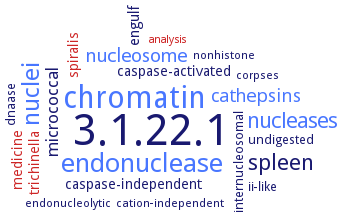Please wait a moment until all data is loaded. This message will disappear when all data is loaded.
Please wait a moment until the data is sorted. This message will disappear when the data is sorted.
A335Term
does not eliminate DNase II activity
A58del
in Japanese, African, Korean and Caucasian subjects, homozygous for the G292 allele. Shows almost no DNase II activity
C11A
-
the mutation decreases the activity
C159A
-
complete loss of activity
C19A
-
complete loss of activity
C267A
-
complete loss of activity
C299A
-
the mutation increases the activity
C308A
-
complete loss of activity
C327A
-
complete loss of activity
C347A
-
complete loss of activity
D107N
-
although the mutant is capable of even greater glycosylation, this mutant results in some loss of activity
H188A
shows similar levels of activity to that of the wild-type
H188K
shows similar levels of activity to that of the wild-type
H188R
in Japanese, African, Korean and Caucasian subjects, homozygous for the A683 allele. DNase II activity is similar to that of the wild-type
N212Q
-
mutation decreases activity, tunicamycin treatment results in complete loss of activity
N266Q
-
mutation decreases activity, tunicamycin treatment results in complete loss of activity
N290Q
-
mutation decreases activity, tunicamycin treatment results in complete loss of activity
N69Q
-
mutation decreases activity, tunicamycin treatment results in complete loss of activity
N86Q
-
mutation decreases activity, tunicamycin treatment results in complete loss of activity
Q329Term
eliminates DNase II activity
R23A
exerts no effect on the DNase II activity
R23H
exerts no effect on the DNase II activity
R23I
in Japanese, African, Korean and Caucasian subjects, homozygous for the G188 allele. DNase II activity is similar to that of the wild-type
R298A
drastically abrogates DNase II activity
R298H
drastically abrogates DNase II activity
R298K
drastically abrogates DNase II activity
R298L
in Japanese, African, Korean and Caucasian subjects, homozygous for the G1013 allele. Reduces the DNase II activity greatly to less than 10% of that of the wild-type
V190I
in Korean subjects,heterozygous for the G688 and A688 alleles. In Japanese, homozygous for the G688 allele. DNase II activity is similar to that of the wild-type
V284A
activity remains low
V284L
activity remains low
V284M
in Japanese, African, Korean and Caucasian subjects, homozygous for the G970 allele. Reduces the DNase II activity greatly to less than 10% of that of the wild-type
AP10T
-
point mutation in the hinge region of LEI, has decreased anti-protease activity. Cells overexpressing wild-type LEI or AP10T-LEI have the same survival rate under unstressed condition. Mutant retains its pro-apoptotic activity when transformed into L-DNase II by an apoptotic stimulus (e.g., hexa-methylene-amiloride treatment). When mutant cells are treated with etoposide they do not present the same survival rate than wild-type cells
H109L
extracellular, about 80% of wild-type activity
H115
extracellular, very little catalytic activity that may be rescued by imidazole, correct protein folding
H132L
soluble, very little catalytic activity. Protein is improperly folded and degraded via the proteosomal pathway within 24 h
H206L
extracellular, about 66% of wild-type activity
H207L
extracellular, about 40% of wild-type activity
H274L
extracellular, about 45% of wild-type activity
H297L
extracellular, very little catalytic activity that may be rescued by imidazole, correct protein folding
H322L
extracellular, activity similar to wild-type
H41L
extracellular, about 60% of wild-type activity
L286A
-
displays a decrease of survival compared to the wild-type
L290A
-
displays no decrease of survival compared to the wild-type
L293A
-
displays a decrease of survival compared to the wild-type
V295A
-
exhibits a significant cell death compared to the wild-type, highest rate of cells with nuclear retention of LEI
H295A

-
mutant can effectively bind DNA, but has a direct role in the catalysis
H295A
the mutant is inactive
Q322Term

eliminates DNase II activity
Q322Term
in Japanese, African, Korean and Caucasian subjects, homozygous for the C1084 allele. Shows almost no DNase II activity
additional information

-
Mutations in nuc-1 block the conversion of TUNEL-reactive DNA to a subsequent TUNEL-unreactive state.
additional information
-
knock-down of enzyme activity by RNAi results in a dramatic reduction in enzymic activity and a significant decrease in total hemocyte numbers. Infection of knock-down flies with Gram negative or positive bacteria results in a severe reduction in fly viability
additional information
-
mutation of the histidine moiety of His 368 completely abolishes endonuclease activity of L-DNase II
additional information
-
DNase IIdeficient mouse embryos accumulate undigested DNA in macrophages, which are present in all tissues, such as the thymus, kidney, interdigit, spleen, and liver. The accumulation of undegraded DNA also stimulates production of interferon-beta, and eventually causes death of the knockout mice. Peripheral blood of DNase II-/- embryos contain massive nucleated erythrocytes and no live DNase II-/- mice are born because of severe respiratory disturbance. Deficiency of the DNase II in adult mice is not lethal




 results (
results ( results (
results ( top
top






